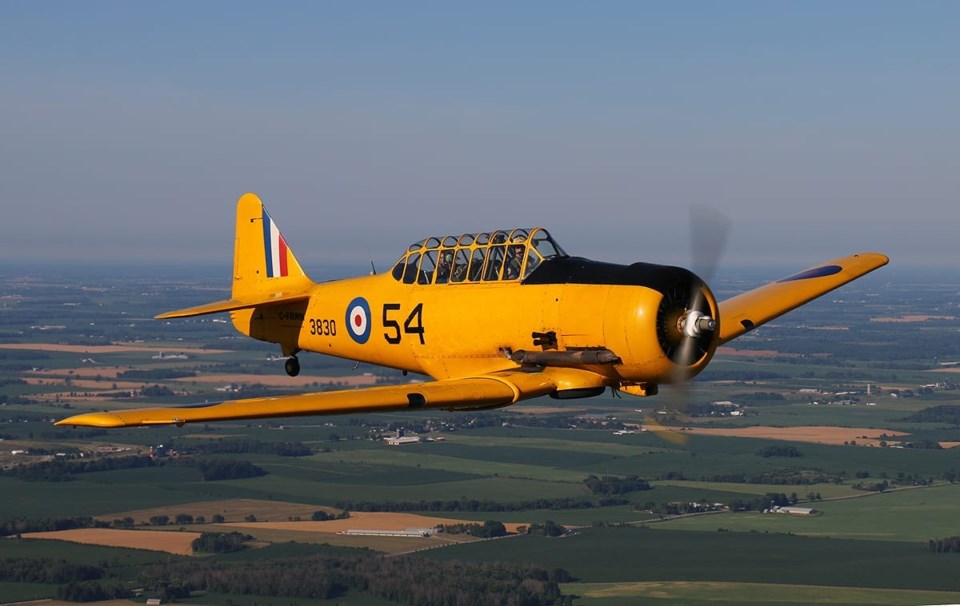BY LEON EVANS
Special to the VOICE
The Community Charity Airshow, previously known as the Rotary Air Show, was this year co-chaired by the Canadian Warplane Heritage Museum's CEO David G. Rohrer, held as usual at the Brantford Airport.
The Canadian Warplane Heritage Museum, Canada's largest flying museum, sent ten airplanes to either fly in the event or sit on the ground as static display, supported by the pilots and crew to answer any questions about the history or flying characteristics of each machine.
Wednesday August 30 the crews met at the Museum for the flight briefing for the 19-nautical mile flight (non-stop) to Brantford to ensure a smooth and safe arrival at a non-controlled (towerless) airport blending with many other expected visiting airplanes.
The "Yellow bird” WWII trainers, a Tiger Moth, a Stearman and a Chipmunk would depart Hamilton first due to their slower inflight speeds. The Harvard, Norseman and Beech 18 would take-off next.
Finally, the PBY 5A Canso (amphibian), DC-3 Dakota and the Mitchell B-25 J were last to leave.
VeRA our Lancaster, unfortunately could not attend.
In addition to the 13 pilots, there were 33 crew members and volunteers to assist arrival/departures and tours of airplanes, explaining the history and idiosyncrasies of these historic airplanes.
At 1400 hrs, Air Boss Bill "Snark" Snelgrove took control of the airspace for a five-mile radius and up to 10,000 feet and it was "Show Time."
The DC-3 had taken off earlier with a group of skydivers (why would anyone jump out of a perfectly running airplane?) and was now able to start the show with the "jumpers" the last out dangling a huge Canadian flag while the National Anthem wafted through the loudspeakers.
The PBY Canso was next on stage displaying its famous wingtip floats, not a fast airplane, but downed airmen in their little yellow dinghies out in the Atlantic or Pacific will never forget the welcoming sight of this airplane coming to their rescue.
By this time, the DC-3 had descended to chase the PBY back and forth in front of the huge crowd. Some 10,000 DC-3s (also called C-47s) went to war.
For years after the war, PBY's were used as water bombers fighting forest fires all over the world.
A variety of aerobatic airplanes then took to center stage performing loops, rolls, spins, all vertical and horizontal, basically displaying maneuvers that our Royal Canadian Airforce pilots would have had to master prior to training on their assigned warbirds before heading out to fight for our freedom, which, need I remind us all, wasn’t free!
Alf Beam with his friend Danny Richer were up next, having done numerous "flypasts" around the Peninsula especially over Welland and Pelham on numerous occasions, such as Remembrance day. They performed with their advanced Trojan T 28 trainers, showing how far WWII trainers had advanced only a few years after peace came in 1945. The North American Trojan saw action in the Vietnam war as a counter-insurgency fighter.
Then it was our turn in the Mitchell B-25 with its twelve 50-caliber machine guns, wearing the white invasion stripes on the wings and fuselage as it would have done on D-Day, so that anxious Allied gunners would not mistake it for the enemy.
The Captain, James Bradley, son of the Museum’s Founding Father Dennis Bradley, flew the Mitchell, assisted by his able Co-pilot, yours truly.
James performed admirably, demonstrating how agile, fast and maneuverable this medium weight bomber really is.
The Mitchell of course, will be remembered for its role in the Doolittle Raid on Japan April 18, 1942, when 16 B-25s took-off the aircraft carrier Lexington in retribution to the unprovoked attack on Pearl Harbor December 7, 1941.
Airshows originated back in the early 1900s, as pilots operating their flimsy biplanes attempted to finance their machines and support their families.
Not much has really changed. We still draw crowds, but now manufacturers introduce their latest commercial and military airplanes in the hopes of selling them to airlines and militaries all over the world.
Throughout the afternoon, the pilots scanned the skies for the forecasted inclement weather, mainly thunderstorms which might stop the show and scatter light aircraft all around. However, the weather gods were smiling on us and the Royal Canadian Airforce "Snowbirds" took to the air and dazzled everyone with a wonderful display of formation aerobatics, ending the very successful Community Charity Airshow for 2017. Air Boss "Snark" declared the airspace open and the mass exodus of airplanes began.
If you were there, you may have noticed me throwing the propeller of the Tiger Moth (50 times!) in an unsuccessful attempt to get it started. How embarrassing it was to watch the Harvard pilot shut down his engine, walk over, pull the propeller through once and it fired to life! Oh well.
Off Runway 23 in Brantford with a left turn out and 19 miles later the "fleet" is back home. Cleaning oil off all surfaces and documenting our log books, then a good debriefing at the RCAF 447 Wing in Mount Hope.
Another successful adventure for the Canadian Warplane Heritage Museum.



